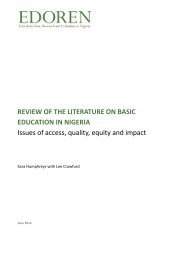review-of-the-literature-on-basic-education-in-nigeria-june-2014-3-1
review-of-the-literature-on-basic-education-in-nigeria-june-2014-3-1
review-of-the-literature-on-basic-education-in-nigeria-june-2014-3-1
You also want an ePaper? Increase the reach of your titles
YUMPU automatically turns print PDFs into web optimized ePapers that Google loves.
Review <str<strong>on</strong>g>of</str<strong>on</strong>g> <str<strong>on</strong>g>the</str<strong>on</strong>g> <str<strong>on</strong>g>literature</str<strong>on</strong>g> <strong>on</strong> <strong>basic</strong> educati<strong>on</strong> <strong>in</strong> NigeriaTable 3.4Provisi<strong>on</strong> <str<strong>on</strong>g>of</str<strong>on</strong>g> <strong>basic</strong> services <strong>in</strong> selected areas <str<strong>on</strong>g>of</str<strong>on</strong>g> NigeriaSERVICESafewaterSafesanitati<strong>on</strong>RuralRuralpoorUrbanUrbanpoorNE NW NC SWTotalpercentage <str<strong>on</strong>g>of</str<strong>on</strong>g>householdswith access39.6 18.9 72.8 28.5 30.3 50.2 48.5 73.1 50.95.6 0.5 29.7 2.6 3.0 4.4 9.8 23.1 13.8Electricity 38.1 12.1 85.3 29.8 29.5 36.9 43.9 78.1 54.1Source: Adapted from <str<strong>on</strong>g>the</str<strong>on</strong>g> Human Development Report Nigeria 2008–2009 (2009: 71), based <strong>on</strong> figures from Nati<strong>on</strong>al Bureau <str<strong>on</strong>g>of</str<strong>on</strong>g>Statistics (NBS) 2006.Several studies and project reports note pupil, teacher and community dissatisfacti<strong>on</strong> with <str<strong>on</strong>g>the</str<strong>on</strong>g> absenceor poor quality <str<strong>on</strong>g>of</str<strong>on</strong>g> water and sanitati<strong>on</strong> provisi<strong>on</strong> <strong>in</strong> schools (e.g. Keat<strong>in</strong>g 2005; Sherry 2008; Copp<strong>in</strong>ger2009; Ant<strong>on</strong><strong>in</strong>is 2010; Co<strong>in</strong>co 2012; UNICEF 2012; Bakari 2013; Dunne et al. 2013, etc.).The c<strong>on</strong>sequences <str<strong>on</strong>g>of</str<strong>on</strong>g> poor water supply and sanitati<strong>on</strong> <strong>in</strong>clude:Pupil and teacher absenteeism (as <str<strong>on</strong>g>the</str<strong>on</strong>g>y leave school to f<strong>in</strong>d water, or a place to ur<strong>in</strong>ate, and maynot return) (Bakari 2013; Dunne et al. 2013); Girls’ n<strong>on</strong>-enrolment or dropout (UNICEF 2012; Bakari 2013); Ill health, which can also lead to absenteeism and dropout (Bakari 2013);Valuable learn<strong>in</strong>g time is wasted as pupils go <strong>in</strong> search <str<strong>on</strong>g>of</str<strong>on</strong>g> dr<strong>in</strong>k<strong>in</strong>g water or are sent to fetch dr<strong>in</strong>k<strong>in</strong>gwater for use <strong>in</strong> school (Chege et al. 2008; Bakari 2013; Dunne et al. 2013); and Disputes with communities over access to water (Dunne et al. 2013).Guarantee<strong>in</strong>g privacy through gender-segregated toilet provisi<strong>on</strong> is c<strong>on</strong>sidered particularly important <strong>in</strong>terms <str<strong>on</strong>g>of</str<strong>on</strong>g> improv<strong>in</strong>g <str<strong>on</strong>g>the</str<strong>on</strong>g> enrolment and retenti<strong>on</strong> <str<strong>on</strong>g>of</str<strong>on</strong>g> girls <strong>in</strong> school (Theobald et al. 2007; Chege et al.2008; Bakari 2013; British Council 2012; UNICEF 2012; Dunne et al. 2013). One report claims thatdropout rates for girls are higher <strong>in</strong> schools (primary and sec<strong>on</strong>dary) that do not have separate toiletfacilities (UNDP Nigeria 2010), while ano<str<strong>on</strong>g>the</str<strong>on</strong>g>r report puts it more str<strong>on</strong>gly: ‘evidence from GEP suggeststhat girls’ attendance rates can rise by as much as 30% when issues such as water and sanitati<strong>on</strong>facilities are addressed’ (British Council 2012: 30). Takahashi (2010) also suggested that <str<strong>on</strong>g>the</str<strong>on</strong>g> 5% rise <strong>in</strong>girls’ enrolments might be due to <str<strong>on</strong>g>the</str<strong>on</strong>g> improved water and sanitati<strong>on</strong> facilities. However, it is unclear <strong>in</strong>all three cases exactly how <str<strong>on</strong>g>the</str<strong>on</strong>g> figures were calculated.Improved access to safe water and sanitati<strong>on</strong> has been <str<strong>on</strong>g>the</str<strong>on</strong>g> focus <str<strong>on</strong>g>of</str<strong>on</strong>g> government and d<strong>on</strong>or-aideddevelopments <strong>in</strong> some states over <str<strong>on</strong>g>the</str<strong>on</strong>g> last few years, <str<strong>on</strong>g>of</str<strong>on</strong>g>ten through SBMCs and PTAs with <str<strong>on</strong>g>the</str<strong>on</strong>g> aid <str<strong>on</strong>g>of</str<strong>on</strong>g>school grants, with many ga<strong>in</strong>s recorded (Chege et al. 2008; Okojie 2008; UNICEF 2009a; USAID 2009;Adediran 2010; Takahashi 2010; P<strong>in</strong>nock 2012). Bauchi State boasts a 44% <strong>in</strong>crease <strong>in</strong> boreholes <strong>in</strong>schools <strong>in</strong> three years and a 27% <strong>in</strong>crease <strong>in</strong> hand-wash<strong>in</strong>g facilities <strong>in</strong> schools (UNICEF 2012). In Kats<strong>in</strong>a,SBMCs have been encourag<strong>in</strong>g pupils to ‘wash’ <str<strong>on</strong>g>the</str<strong>on</strong>g>ir hands with ash and to set up water, sanitati<strong>on</strong> andhygiene (WASH) committees and health clubs (ibid.) A key focus <str<strong>on</strong>g>of</str<strong>on</strong>g> <str<strong>on</strong>g>the</str<strong>on</strong>g> UNICEF CFS <strong>in</strong>itiative across 900schools <strong>in</strong> FCT, Eb<strong>on</strong>yi and Niger states was improv<strong>in</strong>g sanitati<strong>on</strong> and hygiene <strong>in</strong> school; measured <strong>on</strong> aHygiene and Sanitati<strong>on</strong> Scale, 30% <str<strong>on</strong>g>of</str<strong>on</strong>g> <str<strong>on</strong>g>the</str<strong>on</strong>g> sampled 23 schools <strong>in</strong> <str<strong>on</strong>g>the</str<strong>on</strong>g> f<strong>in</strong>al evaluati<strong>on</strong> were adjudged to beexcellent <strong>in</strong> this regard. 1515The composite scale <strong>in</strong>cluded issues such as access to potable water, whe<str<strong>on</strong>g>the</str<strong>on</strong>g>r latr<strong>in</strong>es were safe, <strong>in</strong> good repair and cleanand sanitary, whe<str<strong>on</strong>g>the</str<strong>on</strong>g>r students and staff washed <str<strong>on</strong>g>the</str<strong>on</strong>g>ir hands after us<strong>in</strong>g latr<strong>in</strong>es, and whe<str<strong>on</strong>g>the</str<strong>on</strong>g>r school build<strong>in</strong>gs were clean.EDOREN – Educati<strong>on</strong> Data, Research and Evaluati<strong>on</strong> <strong>in</strong> Nigeria 28



